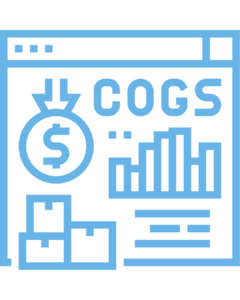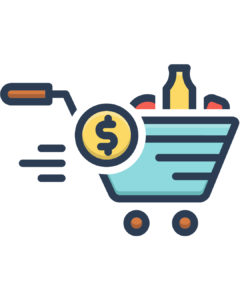Cost of Goods Sold (COGS)
Cost of Goods Sold (COGS) is an accounting term that refers to the direct costs associated with producing or acquiring goods that a company sells during a specific period of time. COGS represents the expenses a business incurs to manufacture, purchase or deliver products or services that it sells to customers.
COGS includes the cost of all the materials used in production, the direct labor costs involved in manufacturing the goods, and any other direct expenses related to the production process. In addition, COGS may also include indirect expenses such as overhead costs, shipping and handling expenses, and other costs associated with getting the products to the customer.

COGS is a significant financial metric because it directly impacts a company’s gross profit margin, which is the difference between the revenue a company generates from the sale of goods and the direct costs associated with producing those goods. Therefore, a lower COGS means a higher gross profit margin and a higher net profit margin for the company.
COGS is reported on a company’s income statement as an expense and deducted from the revenue earned during the same period to arrive at the gross profit.
Cost of Goods Sold (COGS) Formula
The COGS formula calculates the cost of goods sold for a business. It subtracts the total cost of all goods sold during a specific period from the total revenue earned during the same period. The formula for calculating COGS is as follows:
COGS = Beginning Inventory + Purchases During the Period – Ending inventory
Where:
- Beginning inventory is the total cost of all inventory at the beginning of the period.
- Purchases During the Period is the total cost of all inventory purchased during the period.
- Ending inventory is the total cost of all inventory at the end of the period.
A business can determine the cost of goods sold during the period by subtracting the ending inventory from the beginning inventory and adding the total cost of inventory purchases made during the period.
Importance of COGS in SaaS
COGS, or Cost of Goods Sold, is essential for any business, including SaaS (Software as a Service) companies. In SaaS, COGS represents the cost of providing the service to customers, including the cost of hosting, customer support, and other operational expenses.
Here are some reasons why COGS is important in SaaS:
- Helps to determine profitability: COGS is a critical factor in determining the profitability of a SaaS company. By calculating the COGS, a business can determine how much it costs to provide the service to each customer and compare that to the revenue generated from each customer.
- Guides pricing strategy: COGS can help guide the pricing strategy for a SaaS company. By understanding the service’s cost, a business can set a price that covers its expenses and generates a profit.
- Facilitates decision-making: COGS can help SaaS companies make informed decisions about product development, marketing, and other aspects of their business. By understanding the costs associated with providing the service, a business can make decisions that help to optimize its profitability.
- Provides insight into scalability: COGS can provide insights into a SaaS business’s scalability. As a company grows and adds more customers, it may be able to reduce its COGS by achieving economies of scale. By tracking COGS over time, a business can determine if it is becoming more or less efficient in providing the service to customers.

In summary, COGS is an essential metric for SaaS companies as it helps to determine profitability, guides pricing strategy, facilitates decision-making, and provides insights into scalability.
How to Reduce COGS?
Reducing COGS (Cost of Goods Sold) is an essential strategy for any business, as it can help improve profitability and competitiveness. Here are some ways to reduce COGS:
- Negotiate with suppliers: Negotiating with suppliers for better pricing or discounts can help reduce the cost of raw materials or components, reducing COGS.
- Streamline operations: Streamlining production or service delivery processes can help reduce the time and resources required to provide the service, which can lower COGS.
- Optimize inventory management: Improving inventory management practices, such as reducing excess inventory, can help reduce the cost of carrying inventory and improve cash flow, which can lower COGS.
- Improve supplier quality: Improving the quality of materials or components supplied by vendors can help reduce the need for rework or scrap, which can lower COGS.
- Automate processes: Automating repetitive or manual tasks can help reduce labor costs and improve efficiency, which can lower COGS.
- Outsource non-core functions: Outsourcing non-core functions, such as accounting or IT support, can help reduce overhead costs and free up resources to focus on core business activities, which can lower COGS.
- Implement cost-effective technologies: Adopting cost-effective technologies, such as energy-efficient equipment or cloud computing, can help reduce energy costs and IT infrastructure expenses, lowering COGS.

In summary, reducing COGS requires a combination of strategies, including negotiating with suppliers, streamlining operations, optimizing inventory management, improving supplier quality, automating processes, outsourcing non-core functions, and implementing cost-effective technologies. By implementing these strategies, a business can improve profitability and competitiveness by reducing its cost of goods sold.
What is an ideal COGS?
There is no one-size-fits-all answer to an ideal COGS (Cost of Goods Sold), as it varies depending on the industry, business model, and other factors. In general, a lower COGS is better as it indicates that the business can produce or provide its goods or services at a lower cost, which can lead to higher profitability.
However, what is considered a good or ideal COGS can depend on the business’s revenue, gross margin, and industry benchmarks. For example, a business with a high gross margin may be able to afford higher COGS. In comparison, a business with a lower gross margin may need to aim for lower COGS to maintain profitability.
It is also essential to consider the balance between reducing COGS and maintaining product or service quality. Reducing COGS at the expense of quality can lead to customer dissatisfaction, negatively impacting revenue and profitability in the long run.
Therefore, an ideal COGS is one that is low enough to maintain profitability while still providing a quality product or service and remaining competitive in the market. This can vary depending on the industry and business model and may require continuous monitoring and adjustment over time.
Cost of Goods Sold: Companies Examples
Cost of Goods Sold (COGS) is a critical financial metric used by companies in various industries. Here are some examples of companies and how they calculate COGS:
- Manufacturing: Manufacturing companies such as Ford Motor Company calculate COGS by including the cost of raw materials, labor, and overhead expenses required to produce their vehicles.
- Retail: Retail companies such as Walmart calculate COGS by including the cost of goods they purchase from suppliers and sell to customers. This consists of the cost of purchasing and storing inventory, transportation, and any associated taxes or fees.
- Technology: Technology companies such as Microsoft calculate COGS by including the cost of developing and distributing software products, including the cost of research and development, sales and marketing, and overhead expenses.
- Services: Service companies such as consulting firms calculate COGS by including the cost of labor and overhead expenses associated with providing their services to clients.
- Food and Beverage: Food and beverage companies such as Coca-Cola calculate COGS by including the cost of raw materials, labor, and overhead expenses required to produce and distribute their products.

In summary, the calculation of COGS can vary depending on the industry and business model. Still, it generally includes the cost of producing or purchasing goods or services and any associated expenses required to deliver them to customers.
What Metrics Compliments COGS?
Cost of Goods Sold (COGS) is a significant financial metric that reflects the direct costs incurred by a company in producing or delivering goods or services. In addition, several other metrics complement COGS, including:
- Gross margin: Gross margin is revenue minus COGS and reflects the amount of money a company earns after accounting for the direct costs of producing or delivering goods or services. Gross margin is a valuable metric for assessing a company’s profitability and its ability to cover its indirect expenses.
- Operating expenses: Operating expenses are the indirect costs incurred by a company in running its day-to-day operations, such as salaries, rent, and utilities. Operating expenses are subtracted from gross margin to calculate operating income, which reflects the profitability of a company’s core business operations.
- Net income: Net income is the company’s total profit after accounting for all expenses, including COGS and operating expenses. Net income is crucial for assessing a company’s profitability and financial health.
- Inventory turnover: Inventory turnover measures how quickly a company is able to sell its inventory and is calculated by dividing the cost of goods sold by the average inventory balance. A high inventory turnover ratio indicates that a company can sell its inventory quickly. In contrast, a low ratio may indicate that a company is holding onto inventory for too long or is experiencing slow sales.
- Return on investment (ROI): ROI measures the return generated by an investment relative to the cost of the investment. ROI assesses the profitability of a specific project or investment, as well as the overall performance of a company.
In summary, metrics that complement COGS include gross margin, operating expenses, net income, inventory turnover, and return on investment. By tracking these metrics, companies can better understand their profitability and financial performance.
Limitations of COGS

While the Cost of Goods Sold (COGS) is a valuable financial metric for businesses to track, it does have some limitations:
- Limited scope: COGS only captures the direct costs of producing or delivering goods or services, such as raw materials, labor, and direct overhead costs. It does not capture indirect costs such as rent, utilities, and administrative expenses, which can also significantly impact a company’s profitability.
- Inability to capture changes in cost structure: COGS is based on historical costs and may not reflect changes in the cost structure of a business. For example, suppose a company introduces a new product line with a different cost structure than its existing products. In that case, COGS may not accurately reflect the profitability of the new product line.
- Difficulty in comparing across industries: COGS can vary widely across industries, making it difficult to compare the profitability of companies in different sectors. For example, a manufacturing company with high COGS may still be more profitable than a software company with low COGS.
- Limited ability to capture non-production costs: COGS does not capture non-production costs such as marketing and advertising expenses, which can be significant for businesses that rely heavily on branding and advertising to drive sales.
- Does not account for inventory valuation: COGS is based on the cost of goods sold during a specific period and may not accurately reflect changes in the value of a company’s inventory over time. Changes in the value of inventory can have a significant impact on a company’s profitability.
In summary, while COGS is a significant financial metric for businesses to track, it has limitations.
Accounting Methods for Cost of Goods Sold
The periodic and perpetual inventory systems are two standard accounting methods for finding the Cost of Goods Sold (COGS).
- Periodic inventory system: Under the periodic inventory system, companies determine the cost of goods sold by taking a physical inventory count at the end of each accounting period. This involves counting the number of items in inventory and assigning a cost to each item based on the purchase price or the average cost of all items in inventory. The total cost of all items sold during the period is the next step in the calculation, and this amount reflects as the COGS on the income statement.
- Perpetual inventory system: Under the perpetual inventory system, companies keep a running record of all inventory transactions, including purchases, sales, and returns. Each time an item sells, the cost of the item is recorded and deducted from the inventory balance, and the total cost of goods sold updates in real time. This system provides a more accurate and up-to-date view of inventory levels and COGS than the periodic inventory system.
In addition to these two accounting methods, companies may use different cost flow assumptions to determine the cost of goods sold. The most common cost flow assumptions are first-in, first-out (FIFO), last-in, first-out (LIFO), and weighted average cost. These methods determine the order in which inventory sells and can significantly impact the cost of goods sold and the company’s profitability.






